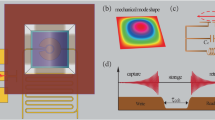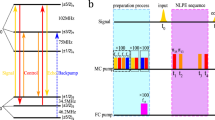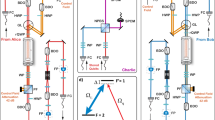Abstract
The information carrier of today's communications, a weak pulse of light, is an intrinsically quantum object. As a consequence, complete information about the pulse cannot be perfectly recorded in a classical memory, even in principle. In the field of quantum information, this has led to the long-standing challenge of how to achieve a high-fidelity transfer of an independently prepared quantum state of light onto an atomic quantum state1,2,3,4. Here we propose and experimentally demonstrate a protocol for such a quantum memory based on atomic ensembles. Recording of an externally provided quantum state of light onto the atomic quantum memory is achieved with 70 per cent fidelity, significantly higher than the limit for classical recording. Quantum storage of light is achieved in three steps: first, interaction of the input pulse and an entangling field with spin-polarized caesium atoms; second, subsequent measurement of the transmitted light; and third, feedback onto the atoms using a radio-frequency magnetic pulse conditioned on the measurement result. The density of recorded states is 33 per cent higher than the best classical recording of light onto atoms, with a quantum memory lifetime of up to 4 milliseconds.
This is a preview of subscription content, access via your institution
Access options
Subscribe to this journal
Receive 51 print issues and online access
$199.00 per year
only $3.90 per issue
Buy this article
- Purchase on Springer Link
- Instant access to full article PDF
Prices may be subject to local taxes which are calculated during checkout



Similar content being viewed by others
References
Cirac, J. I., Zoller, P., Kimble, H. J. & Mabuchi, H. Quantum state transfer and entanglement distribution among distant nodes in a quantum network. Phys. Rev. Lett. 78, 3221–3224 (1997)
Kozhekin, A. E., Mølmer, K. & Polzik, E. S. Quantum memory for light. Phys. Rev. A 62, 033809 (2000)
Fleischhauer, M. & Lukin, M. D. Quantum memory for photons: dark-state polaritons. Phys. Rev. A 65, 022314 (2002)
Kuzmich, A. & Polzik, E. S. in Quantum Information with Continuous Variables (eds Braunstein, S. L. & Pati, A. K.) 231–265 (Kluwer, Dordrecht, 2003)
Furusawa, A. et al. Unconditional quantum teleportation. Science 282, 706–709 (1998)
Van Loock, P., Braunstein, S. L. & Kimble, H. J. Broadband teleportation. Phys. Rev. A 62, 022309 (2000)
Hammerer, K., Wolf, M. M., Polzik, E. S. & Cirac, J. I. Quantum benchmark for storage and transmission of coherent states. Preprint at 〈http://xxx.lanl.gov/quant-ph/0409109〉 (2004).
Briegel, H. J., Dur, W., Cirac, J. I. & Zoller, P. Quantum repeaters: The role of imperfect local operations in quantum communication. Phys. Rev. Lett. 81, 5932–5935 (1998)
Knill, E., Laflamme, R. & Milburn, G. J. A scheme for efficient quantum computation with linear optics. Nature 409, 46–53 (2001)
van der Wal, C. H. et al. Atomic memory for correlated photon states. Science 301, 196–200 (2003)
Kuzmich, A. et al. Generation of nonclassical photon pairs for scalable quantum communication with atomic ensembles. Nature 423, 731–734 (2003)
Julsgaard, B., Kozhekin, A. & Polzik, E. S. Experimental long-lived entanglement of two macroscopic objects. Nature 413, 400–403 (2001)
Blinov, B. B., Moehring, D. L., Duan, L. M. & Monroe, C. Observation of entanglement between a single trapped atom and a single photon. Nature 428, 153–157 (2004)
Hald, J., Sørensen, J. L., Schori, C. & Polzik, E. S. Spin squeezed atoms: A macroscopic entangled ensemble created by light. Phys. Rev. Lett. 83, 1319–1322 (1999)
Liu, C., Dutton, Z., Behroozi, C. H. & Hau, L. V. Observation of coherent optical information storage in an atomic medium using halted light pulses. Nature 409, 490–493 (2001)
Phillips, D. F., Fleischhauer, A., Mair, A., Walsworth, R. L. & Lukin, M. D. Storage of light in atomic vapor. Phys. Rev. Lett. 86, 783–786 (2001)
Schori, C., Julsgaard, B., Sørensen, J. L. & Polzik, E. S. Recording quantum properties of light in a long-lived atomic spin state: Towards quantum memory. Phys. Rev. Lett. 89, 057903 (2002)
Julsgaard, B., Schori, C., Sørensen, J. L. & Polzik, E. S. Atomic spins as a storage medium for quantum fluctuations of light. Quant. Inform. Comput. 3(special issue), 518–534 (2003)
Kuzmich, A. & Polzik, E. S. Atomic quantum state teleportation and swapping. Phys. Rev. Lett. 85, 5639–5642 (2000)
Julsgaaard, B., Sherson, J., Sørensen, J. L. & Polzik, E. S. Characterizing the spin state of an atomic ensemble using the magneto-optical resonance method. J. Opt. B 6, 5–14 (2004)
Fiurášek, J., Cerf, N. J. & Polzik, E. S. Quantum cloning at the light-atoms interface: copying a coherent light state into two atomic quantum memories. Phys. Rev. Lett. (in the press); preprint at 〈http://xxx.lanl.gov/abs/quant-ph/0404054〉 (2004)
Hammerer, K., Mølmer, K., Polzik, E. S. & Cirac, J. I. Light-matter quantum interface. Phys. Rev. A (in the press); preprint at 〈http://xxx.lanl.gov/abs/quant-ph/0312156〉 (2004)
Acknowledgements
We are grateful to N. Cerf and K. Hammerer for discussions. This research was funded by the Danish National Research Foundation, by EU grants QUICOV, COVAQIAL and CHIC, and by the project ‘Research Center for Optics’ of the Czech Ministry of Education. I.C. and E.S.P. acknowledge the hospitality of the Institute for Photonic Sciences, Barcelona, where part of this work was initiated.
Author information
Authors and Affiliations
Corresponding author
Ethics declarations
Competing interests
The authors declare that they have no competing financial interests.
Supplementary information
Supplementary Methods
Describes the calibration of the projection noise level of a coherent spin state and the determination of the parameter k2. Also contains the legend for Supplementary Figure 1. (DOC 34 kb)
Supplementary Figure 1
Presents experimental data used to calibrate the projection noise contribution. (JPG 20 kb)
Supplementary Notes
Contains the proof of the feedback equation valid for an arbitrary quantum state. (DOC 36 kb)
Rights and permissions
About this article
Cite this article
Julsgaard, B., Sherson, J., Cirac, J. et al. Experimental demonstration of quantum memory for light. Nature 432, 482–486 (2004). https://doi.org/10.1038/nature03064
Received:
Accepted:
Issue Date:
DOI: https://doi.org/10.1038/nature03064
This article is cited by
-
Entangling motional atoms and an optical loop at ambient condition
npj Quantum Information (2023)
-
Advances in device-independent quantum key distribution
npj Quantum Information (2023)
-
Three-party authenticated lightweight quantum key distribution without pre-shared key between participants
Quantum Information Processing (2023)
-
High-performance cavity-enhanced quantum memory with warm atomic cell
Nature Communications (2022)
-
A theoretical analysis on quantum memory parameters in ultracold \(^{87}\)Rb and \(^{133}\)Cs alkali species using EIT protocol in the presence of structured light
Quantum Information Processing (2022)
Comments
By submitting a comment you agree to abide by our Terms and Community Guidelines. If you find something abusive or that does not comply with our terms or guidelines please flag it as inappropriate.



